October 1996 - January 1997
In a Nutshell
In a Nutshell
The origin of Apocalypse, as he rises to power to challenge the pharaoh Rama-Tut!
Writer: Terry Kavanagh, with James Felder (issues #2-4)
Penciler: Adam Pollina, Anthony Williams (with Pollina in issue #4)
Inkers: Mark Morales & Harry Candelario (issue #1), Morales (issues #2-3), Morales and Al Milgrom (issue #4)
Letters: Richard Starkings & Comicraft
Colors: Chris Lichtner
Writer: Terry Kavanagh, with James Felder (issues #2-4)
Penciler: Adam Pollina, Anthony Williams (with Pollina in issue #4)
Inkers: Mark Morales & Harry Candelario (issue #1), Morales (issues #2-3), Morales and Al Milgrom (issue #4)
Letters: Richard Starkings & Comicraft
Colors: Chris Lichtner
Enhancements: Malibu
Editor: Mark Powers
Editor-in-Chief: Bob Harras
Plot
Editor-in-Chief: Bob Harras
When a gray-skinned baby with facial disfigurations is left for dead by an Egyptian tribe named Akkaba, he is saved by Baal, leader of a tribe of nomads called Sandstormers, who believes the child to be destined for greatness. Two decades later, when pharaoh Rama-Tut learns of the existence of the now grown child, En Sabah Nur, he dispatches his vizier Logos and top general Ozymandias to capture him, believing him to be destined for power and wanting him as his heir. As pharaoh's forces clash with the Sandstormers, Baal takes his son into the crashed spaceship from which Baal rescued the time-traveling Rama-Tut when he first arrived in Egypt; when Baal dies, En Sabah Nur claims the technology in the ship for himself. Meanwhile, Ozymandias returns a conquering hero, though Rama-Tut is upset he didn't capture En Sabah Nur and announces his intention to take Ozymandias' sister Nephri as his bride. Seeking revenge, En Sabah Nur travel's to Rama-Tut's city. Disguised as a slave, he gets caught in the power struggle between Logos and Ozymandias just as the time-traveling Fantastic Four arrive in Rama-Tut's court. Rescued by Nephri, he falls in love with the woman, but when she rejects him due to his appearance, his mutant powers activate, and he uses Rama-Tut's technology to transfigure and enslave Ozymandias. As Rama-Tut flees Egypt in the wake of his encounter with the Fantastic Four, En Sabah Nur christens himself Apocalypse, and sets out to destroy the weak!
Firsts and Other Notables
Firsts and Other Notables
This miniseries lays out the origin of Apocalypse for the first time, confirming him to have been born in ancient Egypt (roughly five thousand years ago) and born a mutant, where he was taught the "survival of the fittest" credo that would come to define his life and was drawn into a power struggle involving Egypt's ruling class at the time. It is, for the most part, consistent with the various bits of previously-established backstory for the character (he is born of the tribe Akkaba, for example, a reference to Cable #17-19) and, remarkably, has stood the test of time since its release, with no overt retcons from later stories eliminating things here and all subsequent additions to his backstory largely falling into place alongside this story.
To a much lesser degree, this series also offers an origin for Ozymandias, revealing him to have been a power-hungry Egyptian general who ran afoul of the young Apocalypse and ended up transformed into stone and forced to serve as Apocalypse's prophet/scribe, as he appears in present day stories.
Rama-Tut, the pharaoh of Egypt in the story who seeks out the young Apocalypse is, of course, one of the forms of the time-traveling Kang the Conqueror (with the iteration of Rama-Tut appearing in this story being the earlier, less-benevolent Rama-Tut, as opposed to the later, post-Kang Rama-Tut who aided the Avengers on occasion). It is implied in this story that it is Apocalypse who led the conqueror-turned-pharaoh to ancient Egypt in the first place, as Kang sought to control the power of the young Apocalypse he knew was destined to rise in that time.
The Fantastic Four appear briefly in issue #3, which sets that issue as occurring at the same time as Fantastic Four #19, the first time they traveled back to Egypt and battled Rama-Tut.
The FF/Rama-Tut encounter is a surprisingly-busy inflection point for time travelers, as later stories (relative to FF #19) will also place a present-day Doctor Strange and a contingent of West Coast Avengers in the vicinity of Rama-Tut and the FF in this time, though they don't appear in this series.
Each issue of this series features a wraparound cover.
Creator Central
The series is written (mostly) by longtime editor and current Excalibur writer Terry Kavanagh. Art (again, mostly) comes from X-Force artist Adam Pollina, who took a break from that series to work on this one.
A Work in Progress
A Work in Progress
The infant Apocalypse is given the name En Sabah Nur, which is said to mean "the morning light" in Arabic, though that apparently doesn't translate correctly, and it seems unlikely that ancient Egyptian nomads would be speaking Arabic anyway.
Records from Kang/Rama-Tut's time refer to Apocalypse as "The First One" ie the first mutant.
In issue #4, En Sabah Nur takes the name Apocalypse for the first time.
He also talks about "casting off his form", using his mutant powers to grow larger and stronger, a reference to his earliest appearances in which his principal abilities were shown to be the manipulation of his own mass.
Austin's Analysis
Next Issue
Austin's Analysis
Did Apocalypse need an origin story? And did that origin need to come in the form of four issue miniseries? Not really - the brief history he gives in X-Factor #24 is really enough: he's a long-lived mutant whose longevity has led him to embrace a belief in extreme Darwinism. But given the sheer popularity of the character in the wake of "Age of Apocalypse" and cartoon appearances, and the state of the market in late 1996, an origin-focused miniseries is hardly surprising. And honestly, as these things go, it could be much worse.
I remember enjoying this when it first came out, and I mostly enjoyed it revisiting it again. Some of that comes from the setting, which is both unique (not a ton of comic stories are set in ancient Egypt, aside from a few that get referenced here) and far enough removed from current events that it can do its own thing. If anything, like The Adventures of Cyclops and Phoenix (another miniseries set entirely in a strange land without any cutaways to current events), the setting allows Apocalypse to function as a proper protagonist in the story, someone whose actions drive the plot and experiences an arc as the story goes along. The tale of the prophesized being who becomes what he is prophesized to be due to people reacting to the prophecy is hardly new (to the X-Men, to comics, or to Western literature) but it works for a character whose existence is, again, steeped in antiquity.
The setting also gives Adam Pollina a chance to shine as well, rendering a world as alien, in its way, as the one created by Gene Ha in Cyclops and Phoenix. Pollina's biggest struggles as X-Force artist from the fact that he doesn't have a traditional superhero style, but that becomes more of an asset than a liability here, as he renders the young Apocalypse and an assortment of archetypal characters with zeal and verve; look closely, and you can see Ozymandias little goatee sneer along with him. Additionally, the inclusion of Rama-Tut in Apocalypse's backstory, far from making his story feel smaller, makes him feel bigger, tying his origin to a bedrock Silver Age Marvel story (something reinforced by the brief appearance of the Silver Age FF in issue #3). This is a character, it says, bigger than the world of the X-Men, one interwoven into the fabric of Marvel history. Yet even then, Kavanagh smartly keeps the connection limited: Apocalypse never crosses paths with the FF, never learns the full truth of Rama-Tut's origins and future. It connects him to that bit of lore, but doesn't change everything that's come before.
All in all, this miniseries works not because it's an origin story for Apocalypse, but because it's an entertaining story featuring Apocalypse. If it occasionally relies a bit too heavily on archetypes/stereotypes to do so, well, the atypical Adam Pollina art is there to punch things up and help the familiar feel fresh. Certainly, in the grand scheme of mid-to-late 90s X-Men miniseries, this rises towards the top, where similarly-focused, self-contained stories with distinctive art reside.
Next week: Graydon Creed comes to an end in X-Factor #130, and Cable's battle in the Microverse concludes in Cable #39!
Like what you read? Then support us on Patreon & gain access to exclusive reviews of Classic X-Men, X-Men: The Animated Series and more!
Like what you read? Then support us on Patreon & gain access to exclusive reviews of Classic X-Men, X-Men: The Animated Series and more!

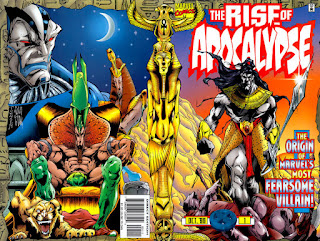

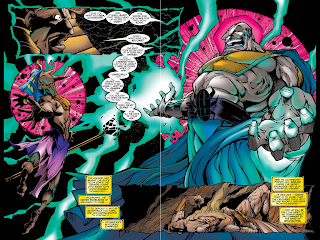
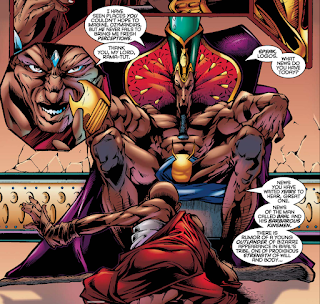
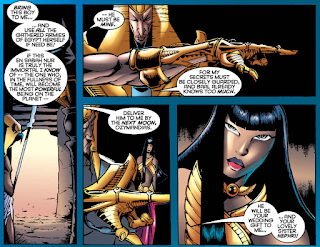
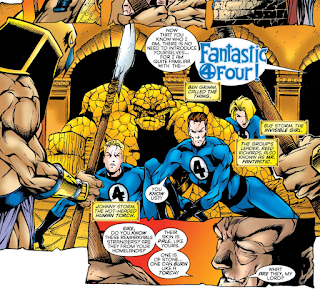


I've never read this series. I liked Apocalypse well enough, but never felt I needed to know his origin (unlike Mister Sinister, whose origin I eagerly devoured in FURTHER ADVENTURES OF CYCLOPS AND PHOENIX). So I have no real opinion here, other than to say that I've always liked the idea of tying Apocalypse's backstory in with the saga of Rama-Tut.
ReplyDelete(Have Apocalypse and Kang ever crossed paths? Unless it's happened since I stopped reading a decade or more back, I don't think so -- which is odd, because it feels like a natural place to go, following from this series.)
"...a gray-skinned baby..."
Funny thing about this is, once upon a time, gray was (for some reason) the default color for ALL Egyptian characters! See Scarlet Scareb from INVADERS, Asp of the Serpent Society, Storm's mentor Achmed el Gibar, Nova's enemy the Sphinx (as well as the female Sphinx from NEW WARRIORS), and others. So in the Silver or Bronze Ages, Apocalypse being gray would have just been standard coloring and not unusual in-universe.
Indeed, I have occasionally wondered if Apocalypse was made Egyptian to retroactively explain the gray skin, since it was still the practice of coloring Egyptians gray when that initial revelationw as made.
I like Apocalypse as a character, but I really wish he either A. Wasn't a mutant or B. Wasn't as old. When X-Men started Mutants were a relatively new phenomenon and thought to be the next step in human evolution. Then we got Apocalypse and the X-Ternals showing that mutants have been around for awhile. Now, between Aaron's Avengers and what Hickman did we found out that mutants have pretty much always been around. I'm not saying that I haven't enjoyed these things, just that it changes the feel of the X-Men as a whole.
ReplyDeleteMaybe it's just selective memory/reading on my part, but I feel like the general sense of mutants exploding in population in the modern era is still in place - we just know mutants have always existed/existed for a long time via characters like Apocalypse and the X-Ternals. But at those times, mutants were rare and scattered, while the notion of mutants as full-on separate species known to the general public with a culture and zeitgeist all its own is still tied to a quasi-20th century emergence.
DeleteI agree with Drew. I like the idea that Mutants saw a large explosion of births after the atomic bomb creation and eventual drops, creating and increasing mutant births at that point. Making it where mutants have been around forever basically nulls the connections between Charles Xavier's father and the others connected with his field of work and their eventual children all being mutants. It's one thing if it's really rare previously and increased in the 60's but making it common throughout time nulls a lot of the early development of the X-Books mythos.
ReplyDeleteI was still going strong on comics when this was released but I picked up issue #1 and that Adam Pollina art drove me from reading it nor picking up the rest of the issues. I figured that it covered his history tied to Egypt from just the first issue and since it didn't cover a period of time other than this, there wasn't much more for me to need to pick up after issue #1 since it's just building more on that and not providing any further relevant info.
ReplyDeleteIn the 3rd non-cover image, on his throne, Rama-Tut looks alarmingly like the Flaming Carrot. (And that headrest looks alarmingly like a cross between Audrey II from Little Shop of Horrors and a vampiric watermelon.)
// not a ton of comic stories are set in ancient Egypt //
I mean, unless you count hieroglyphics, in which case…